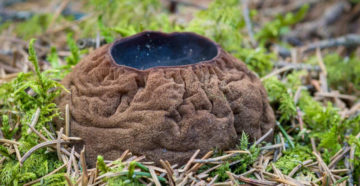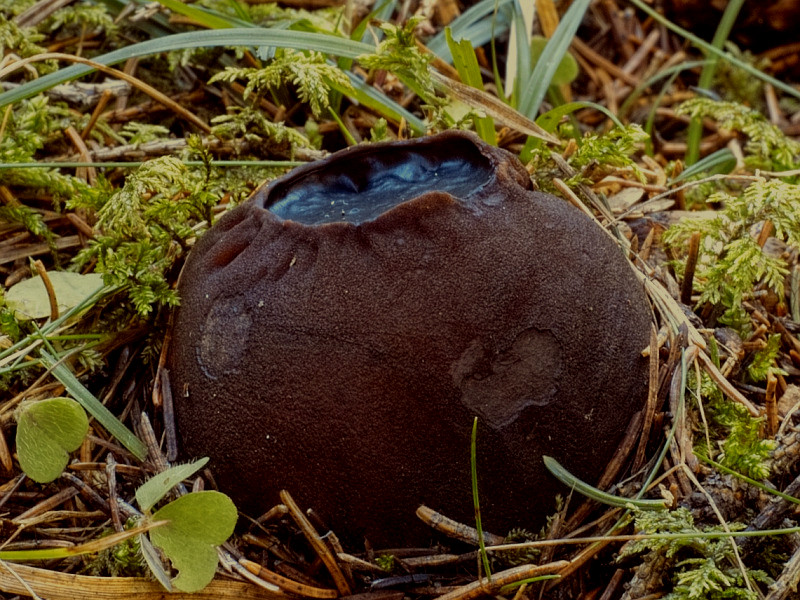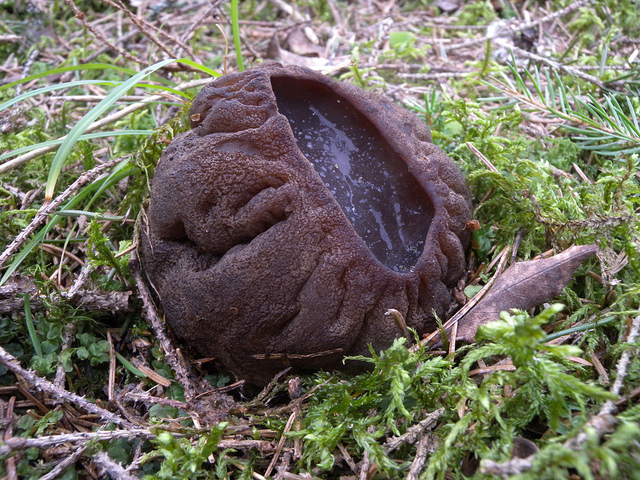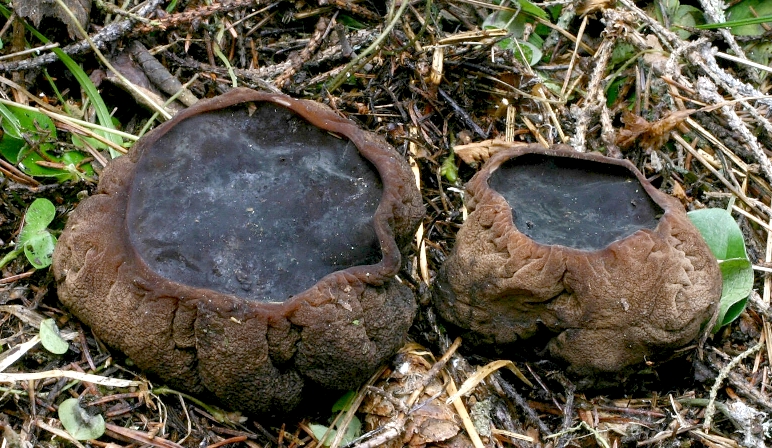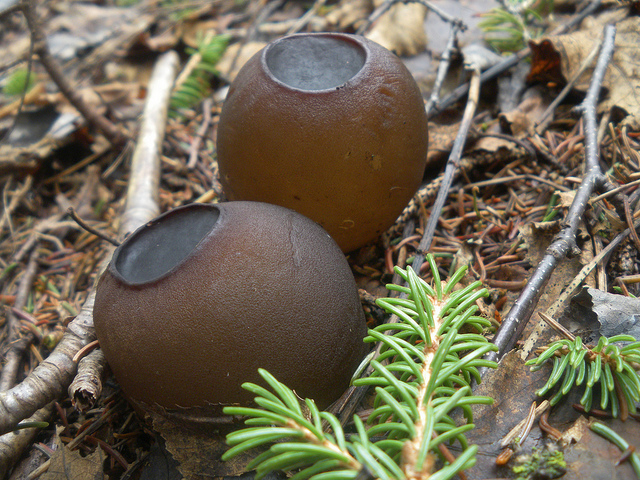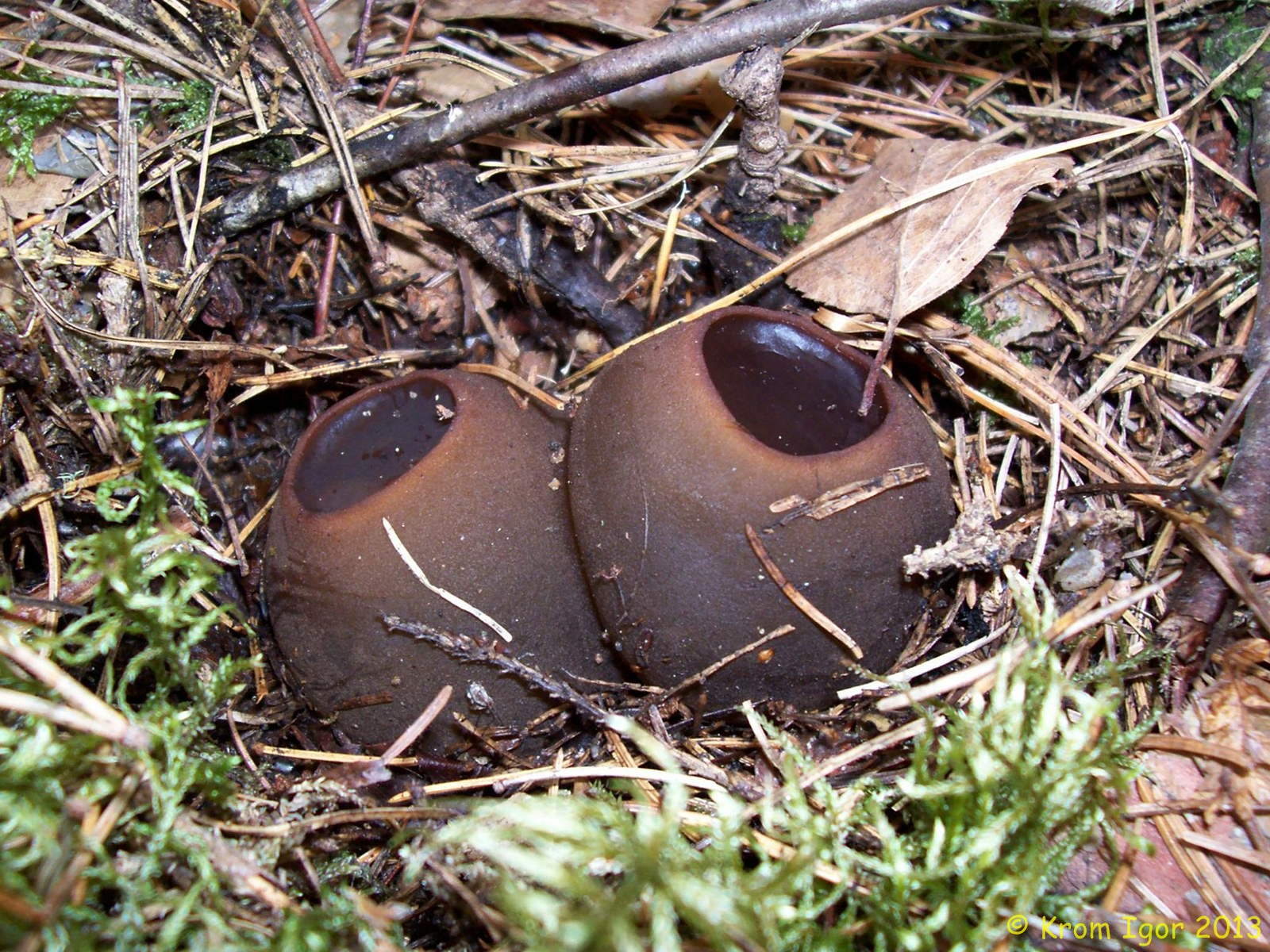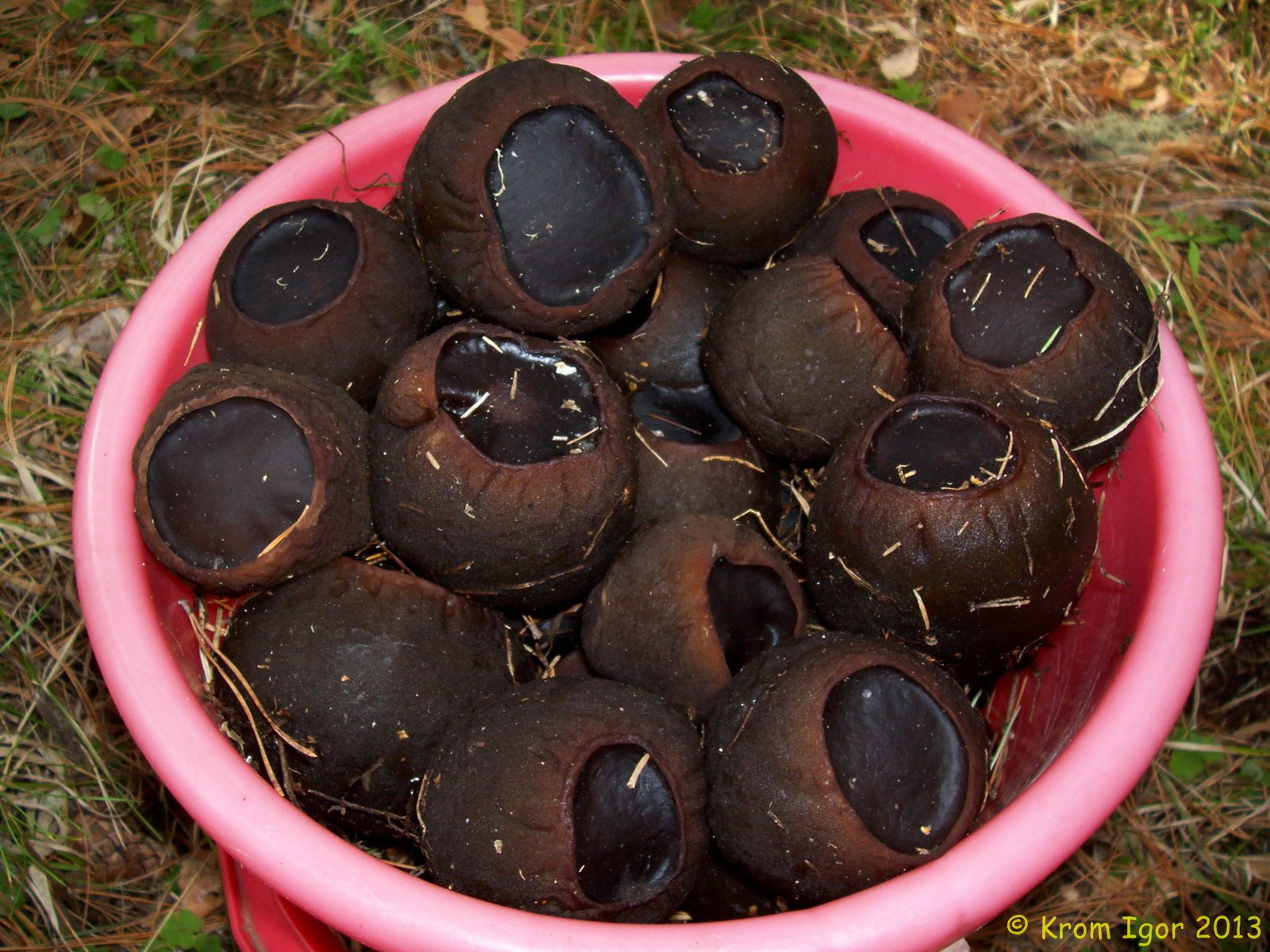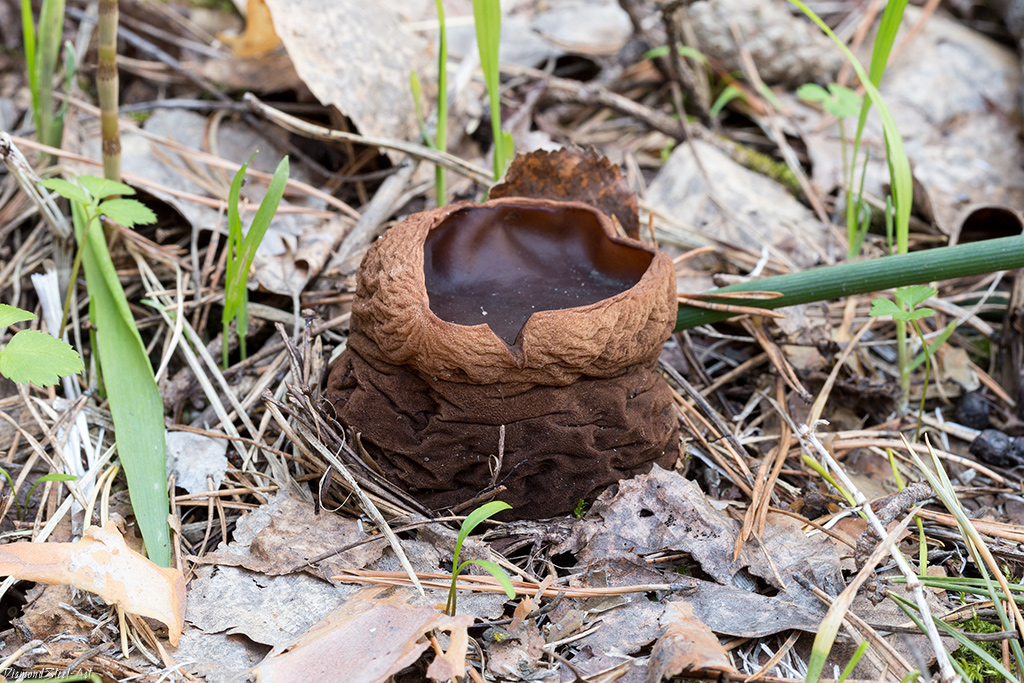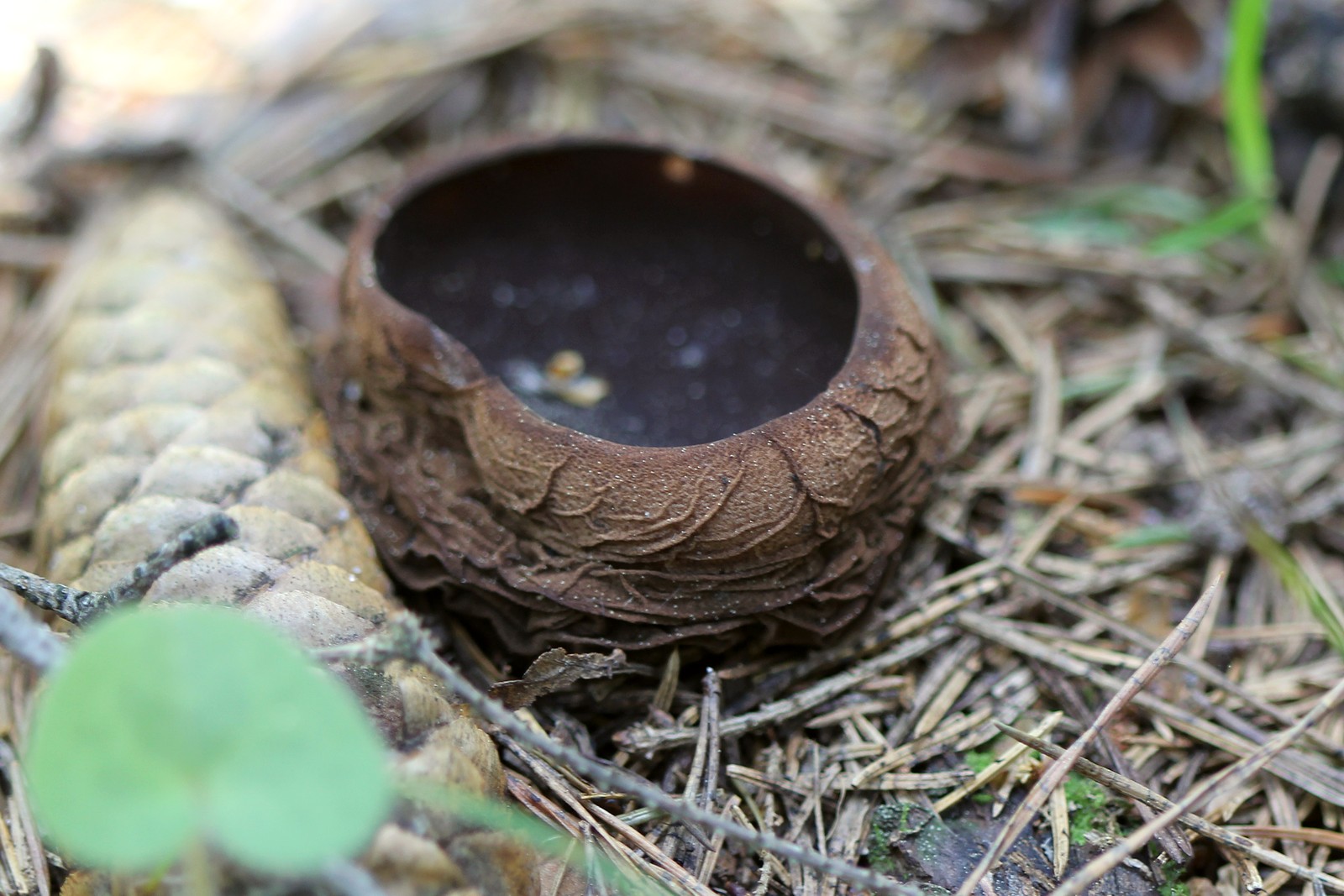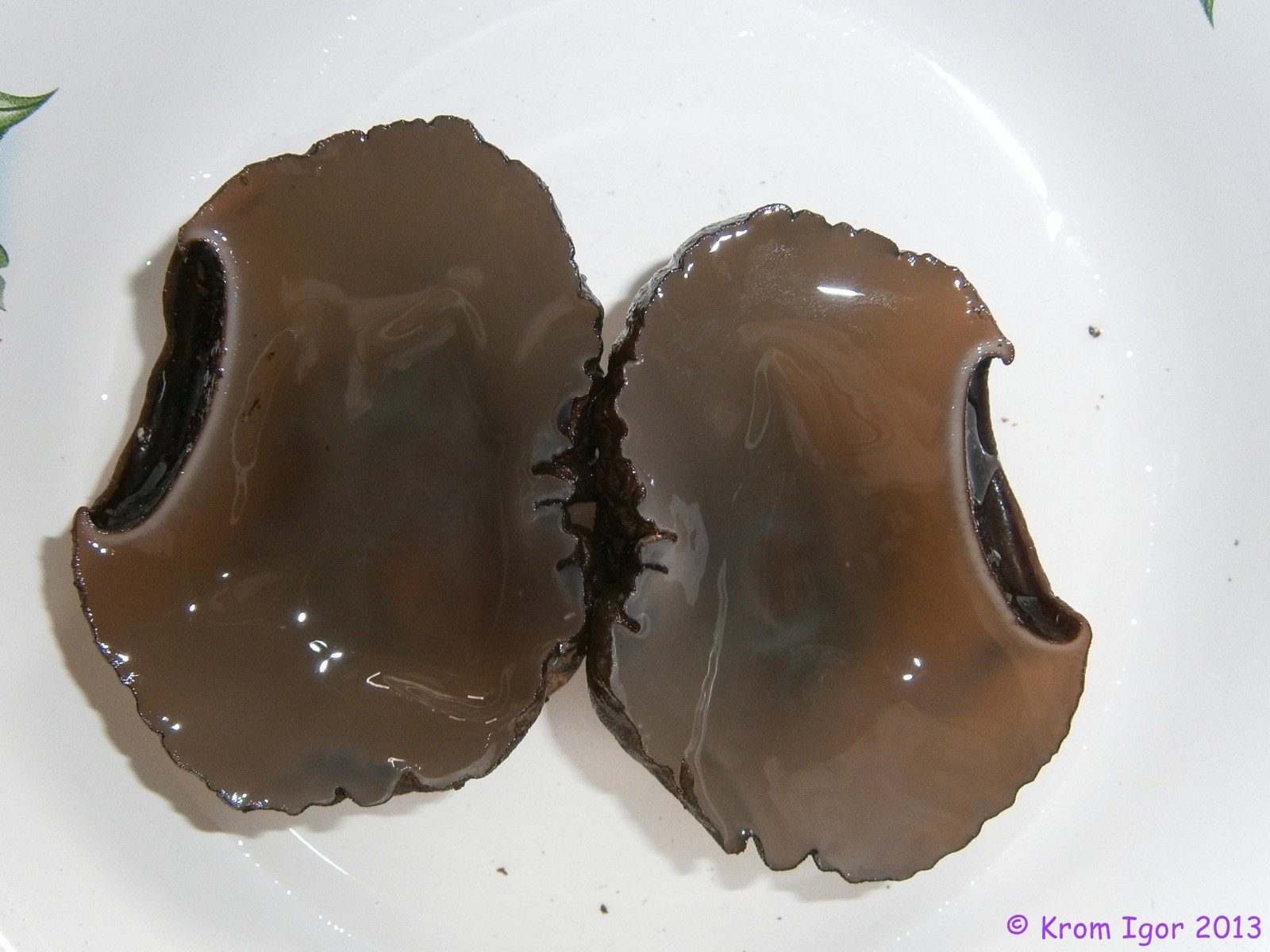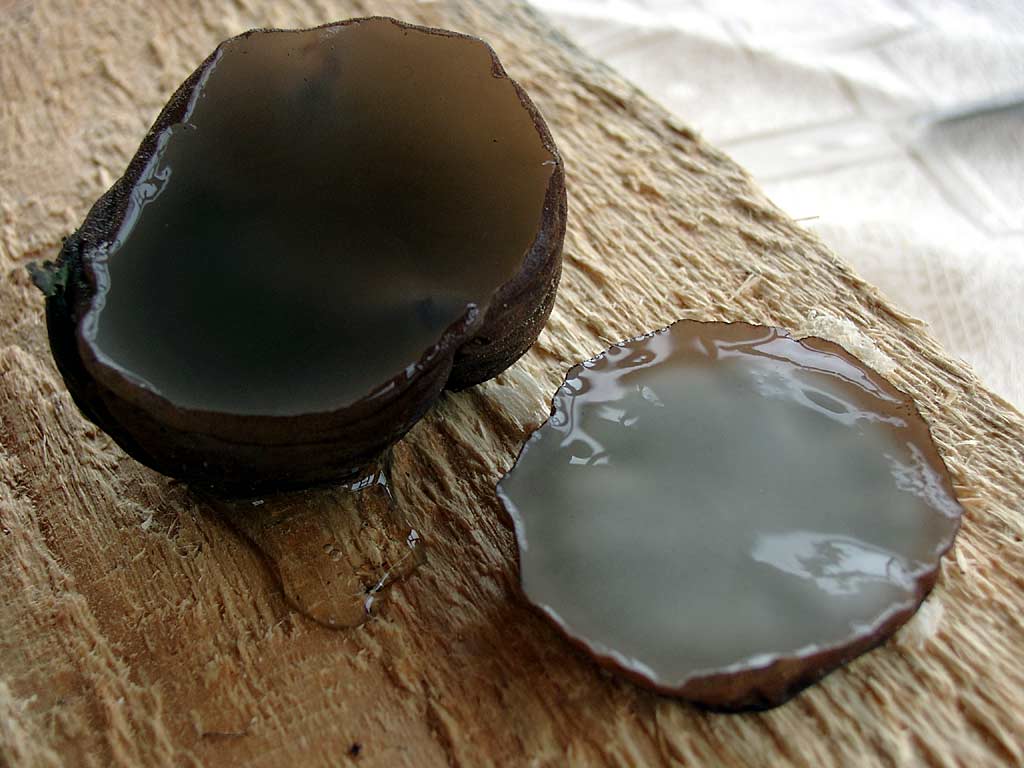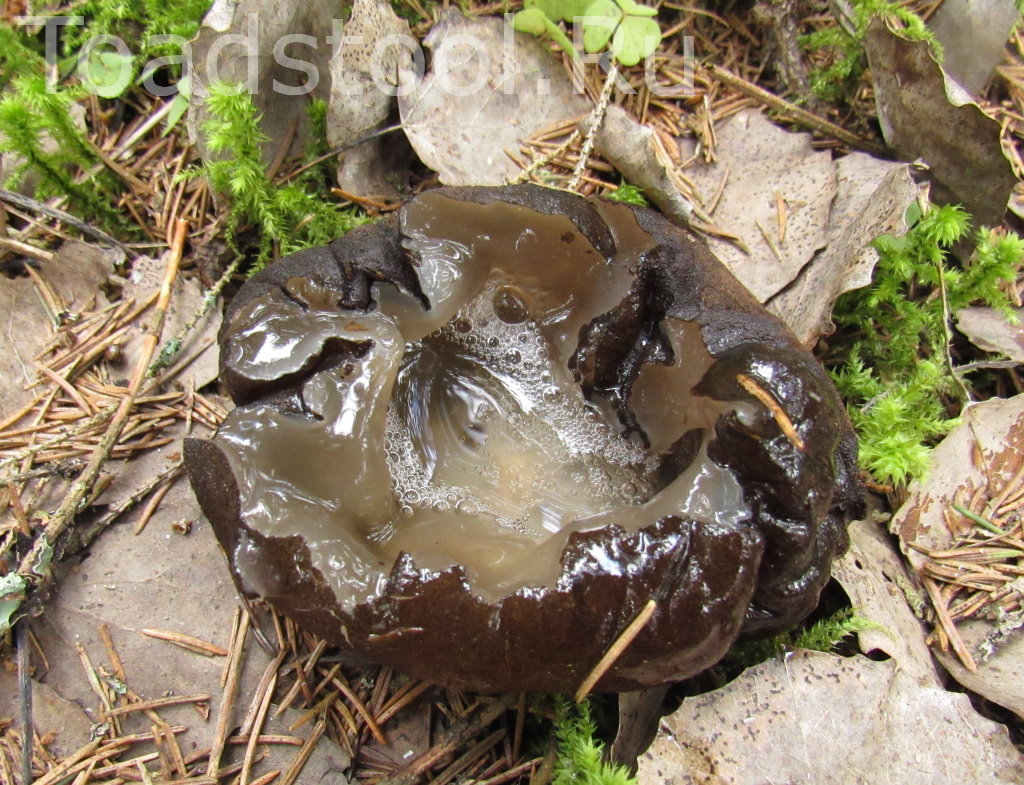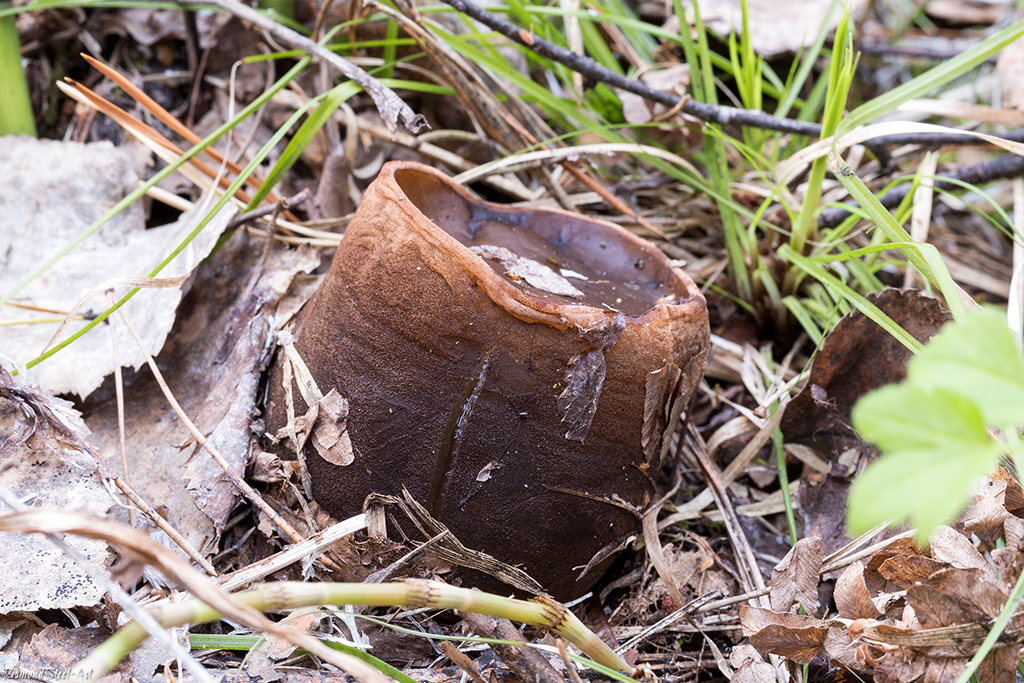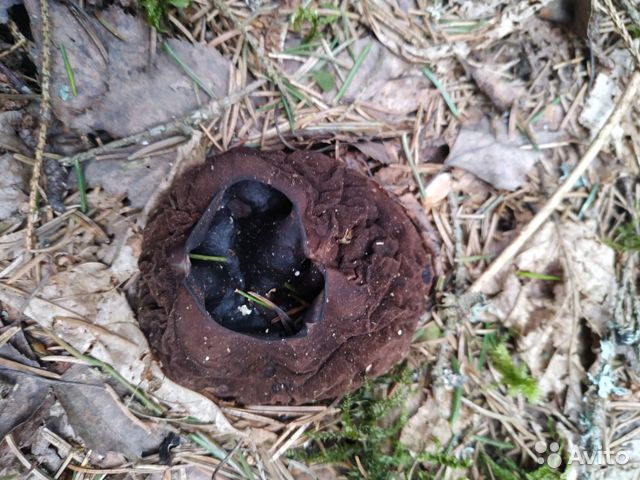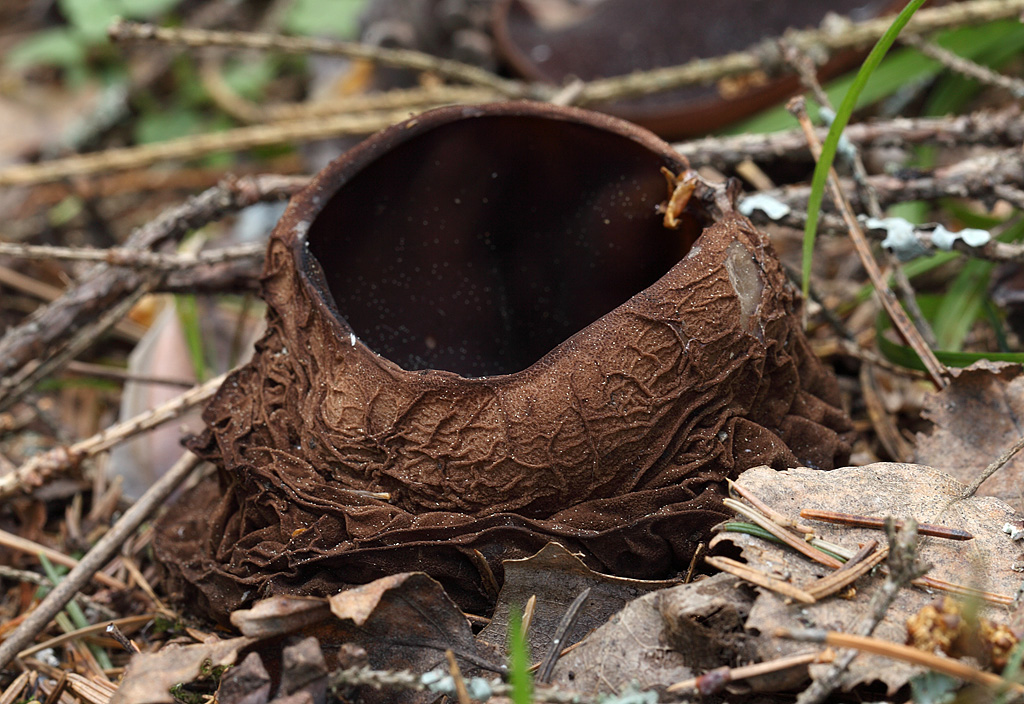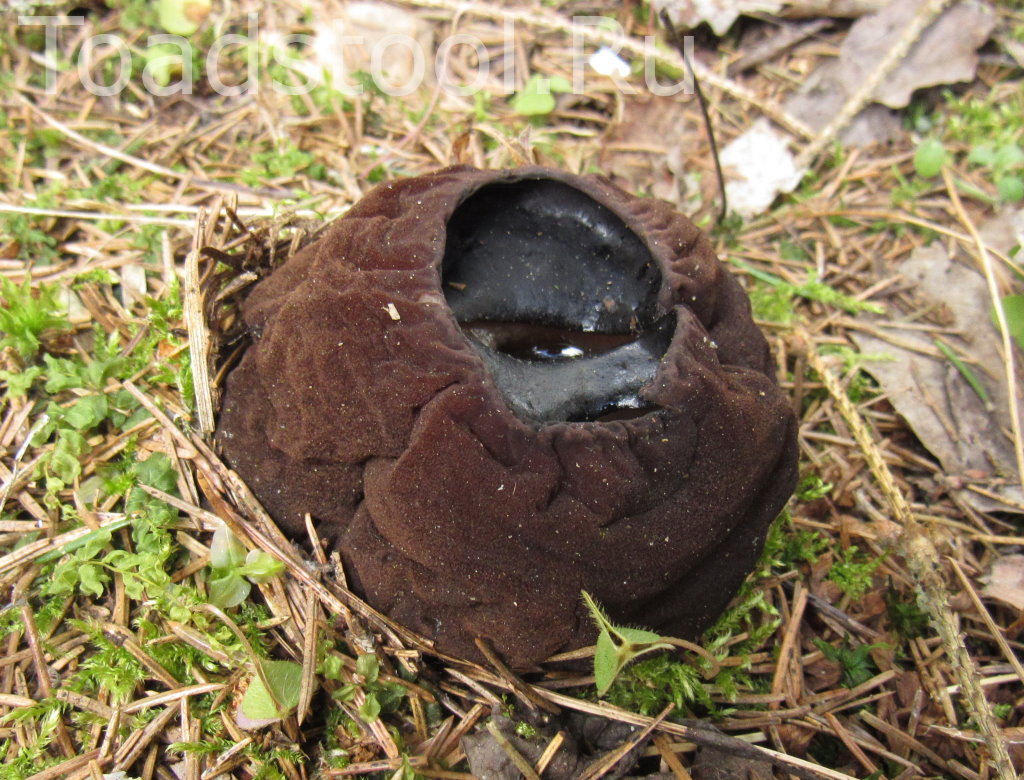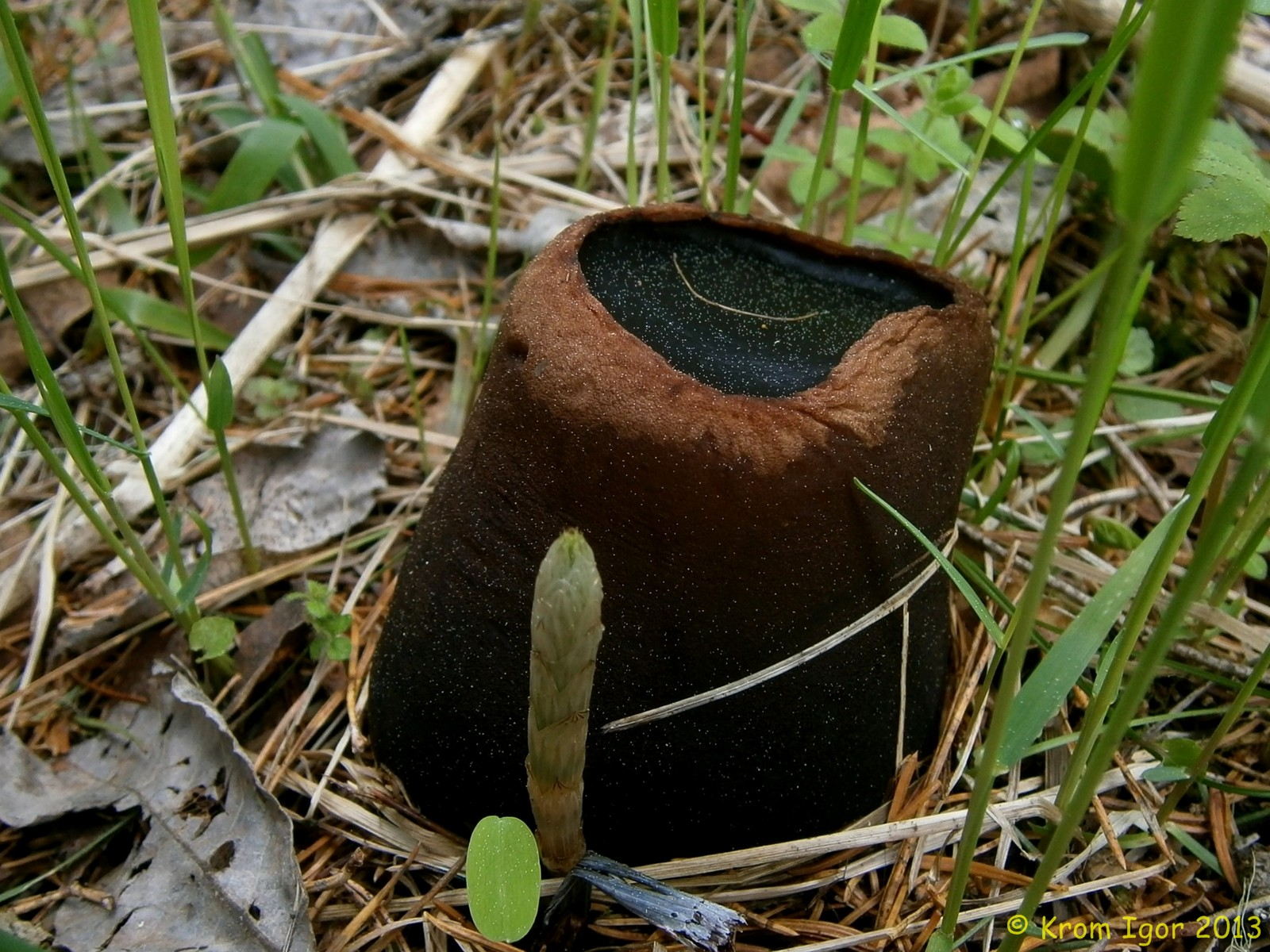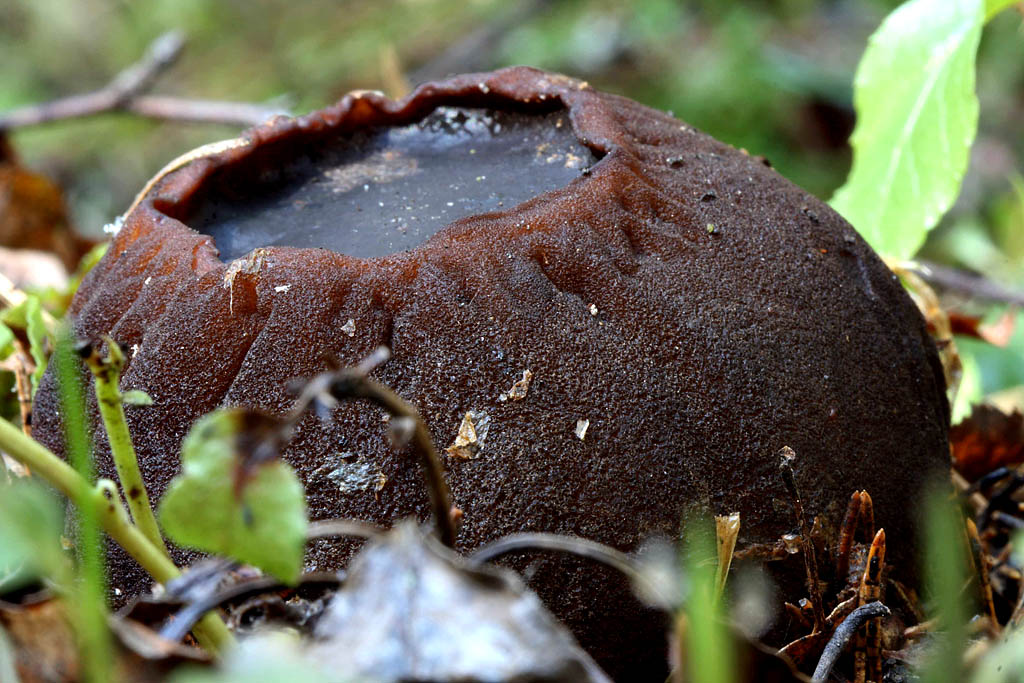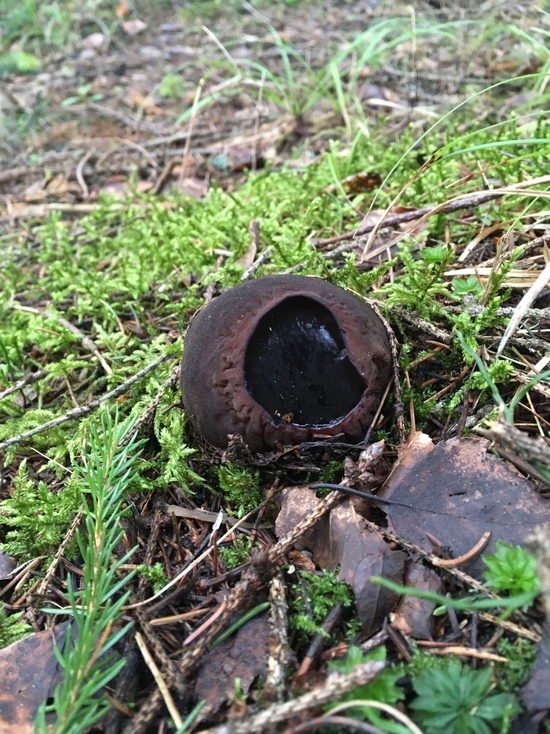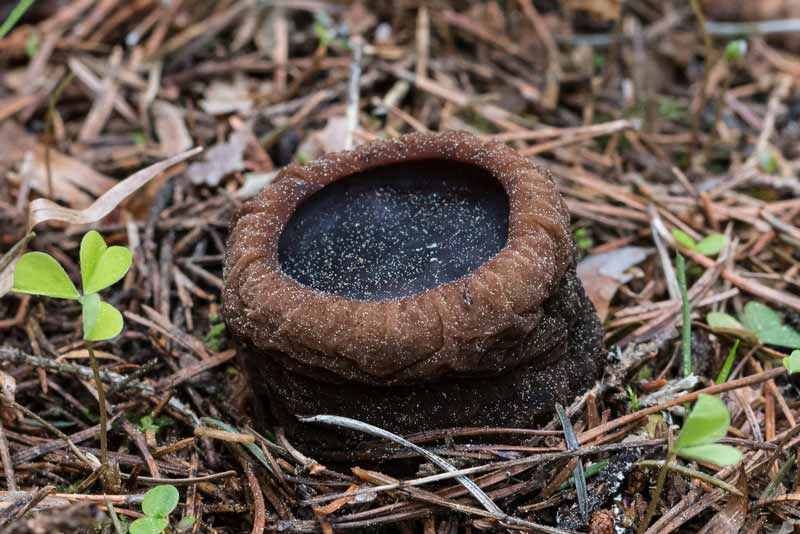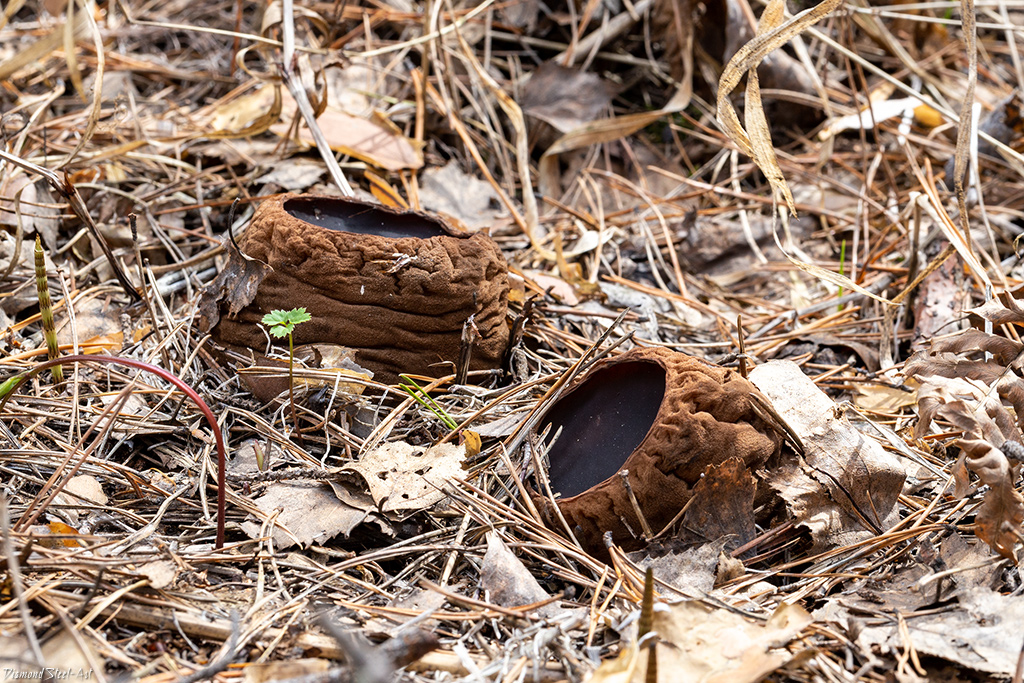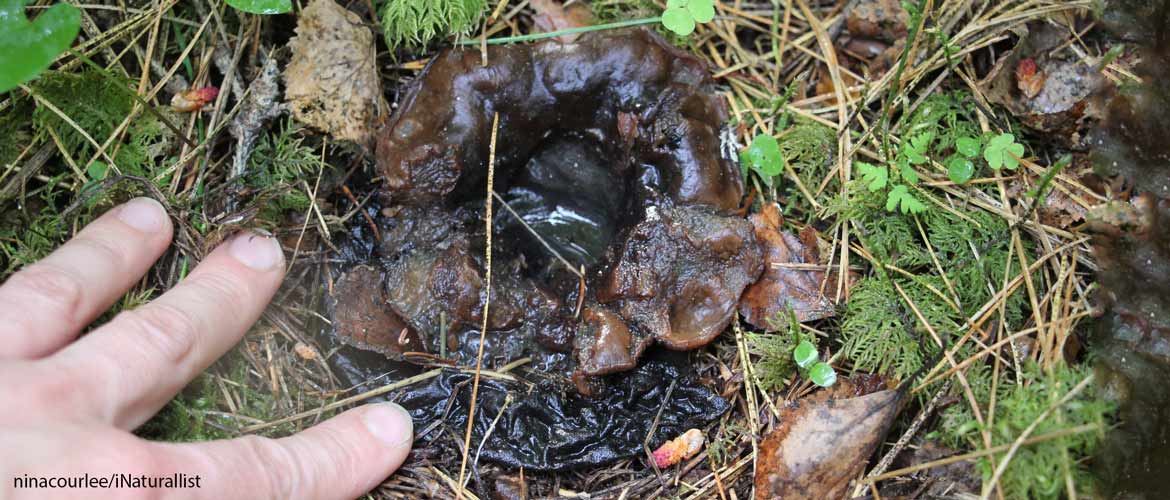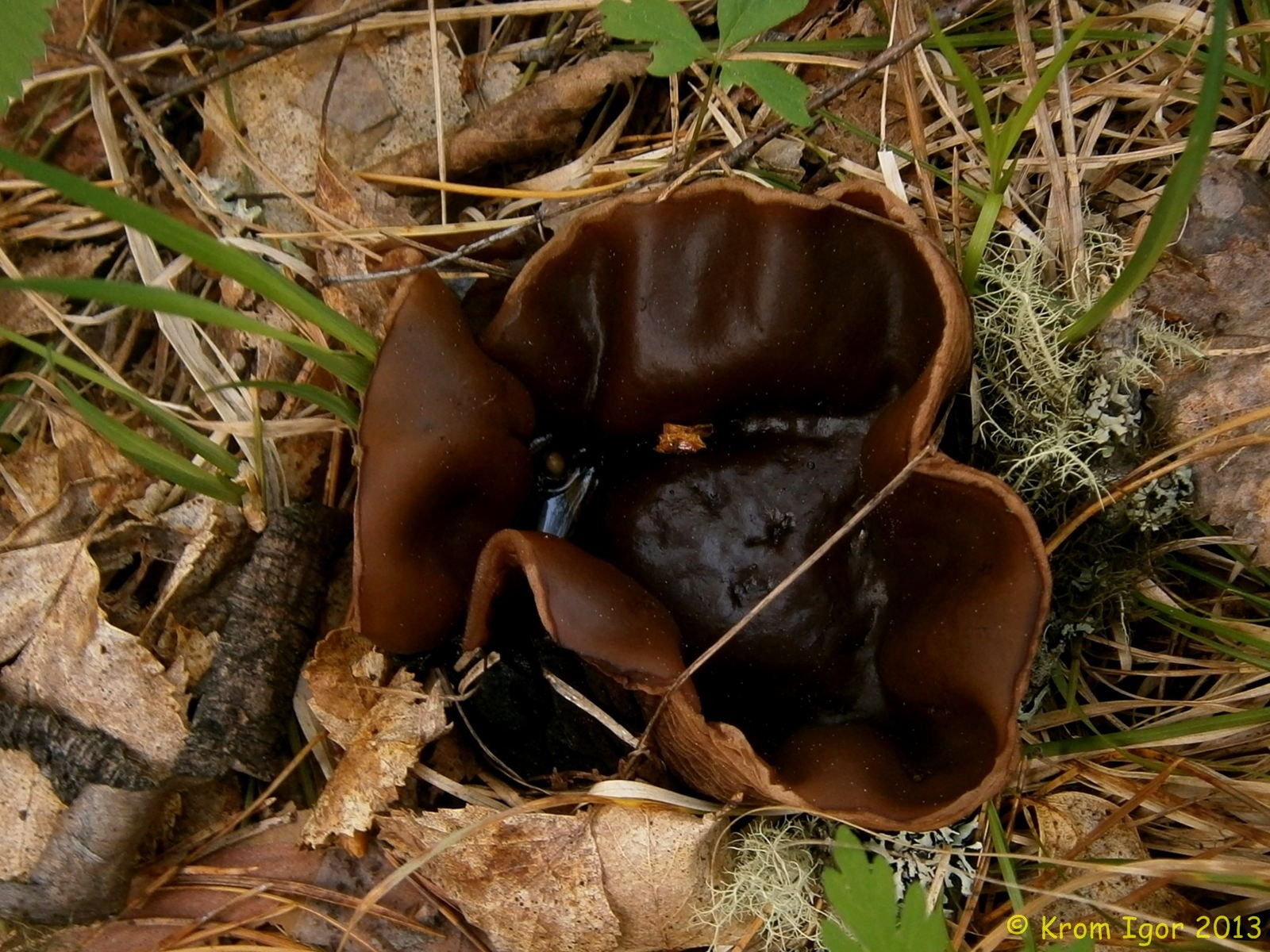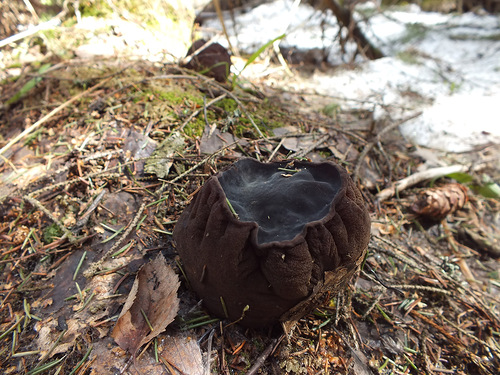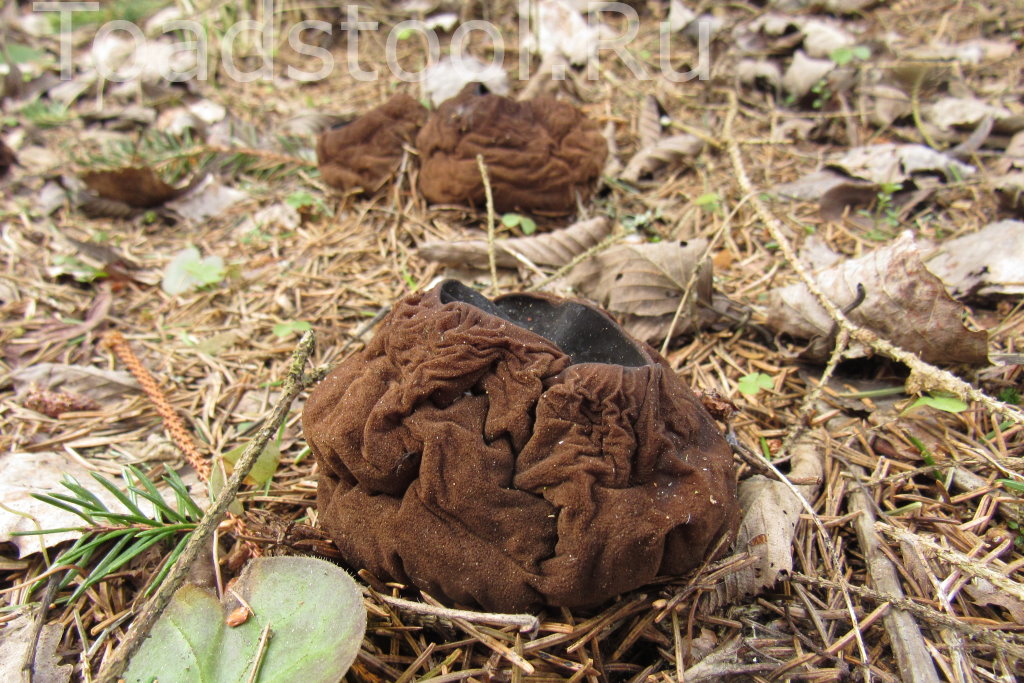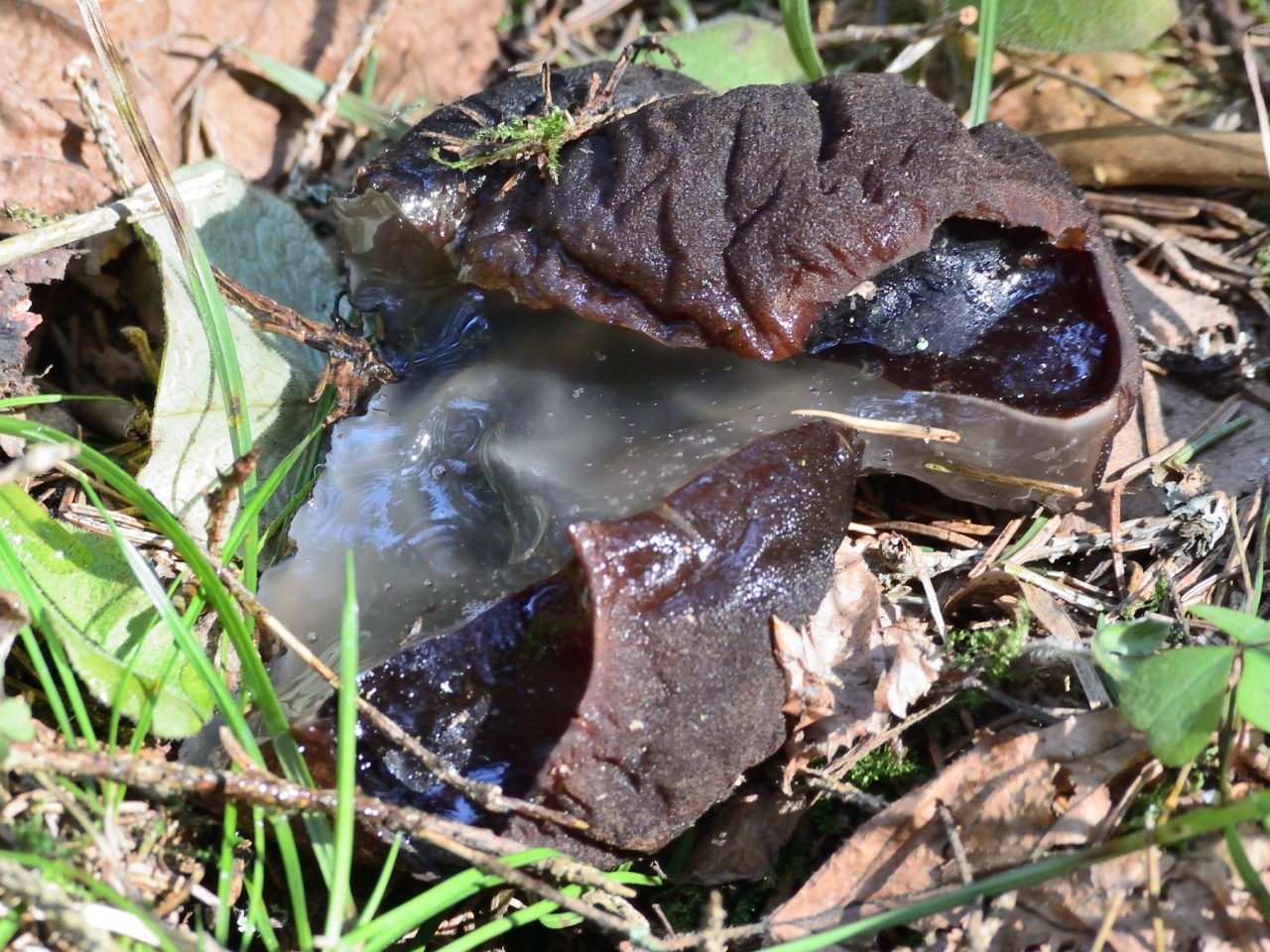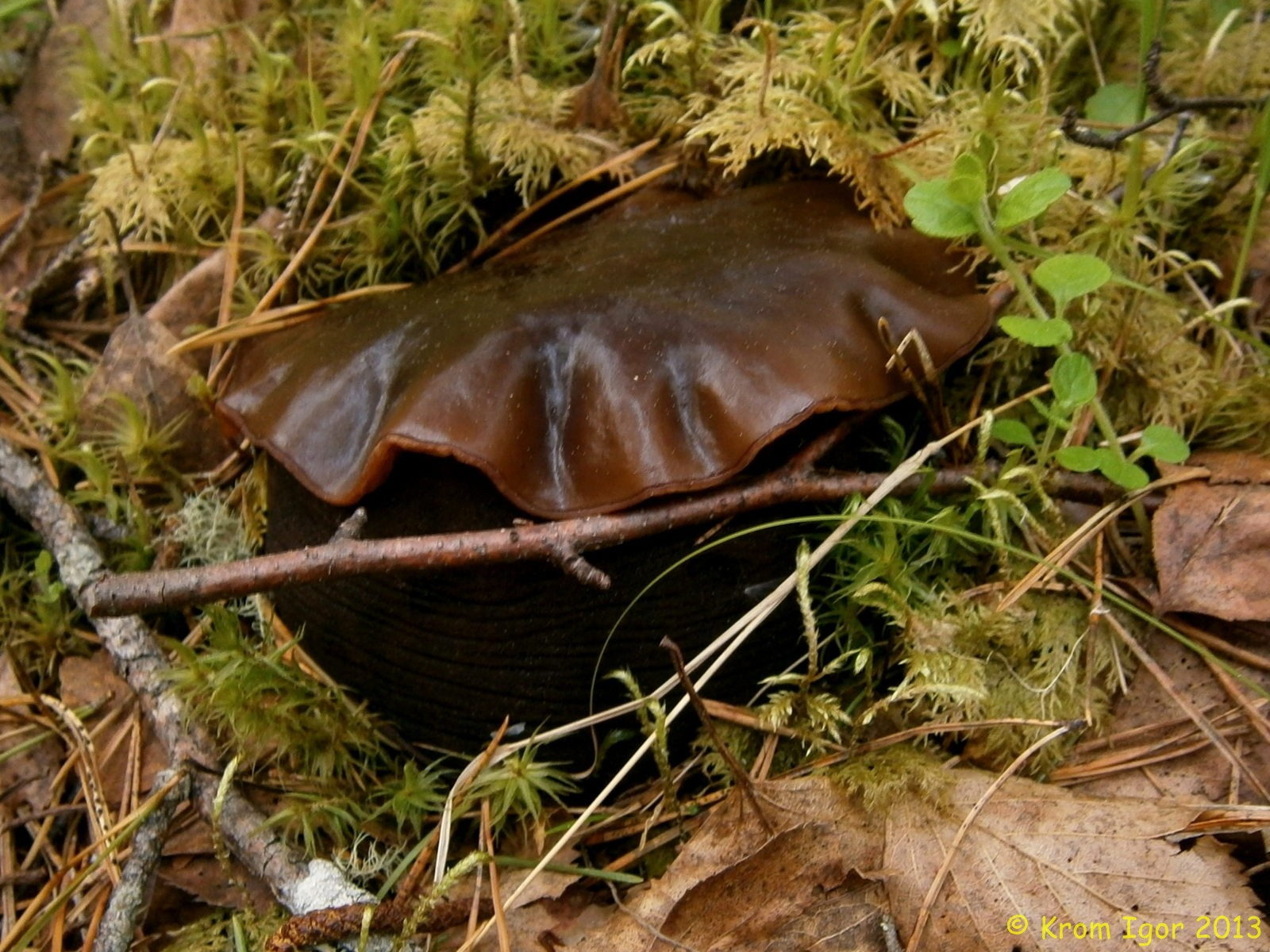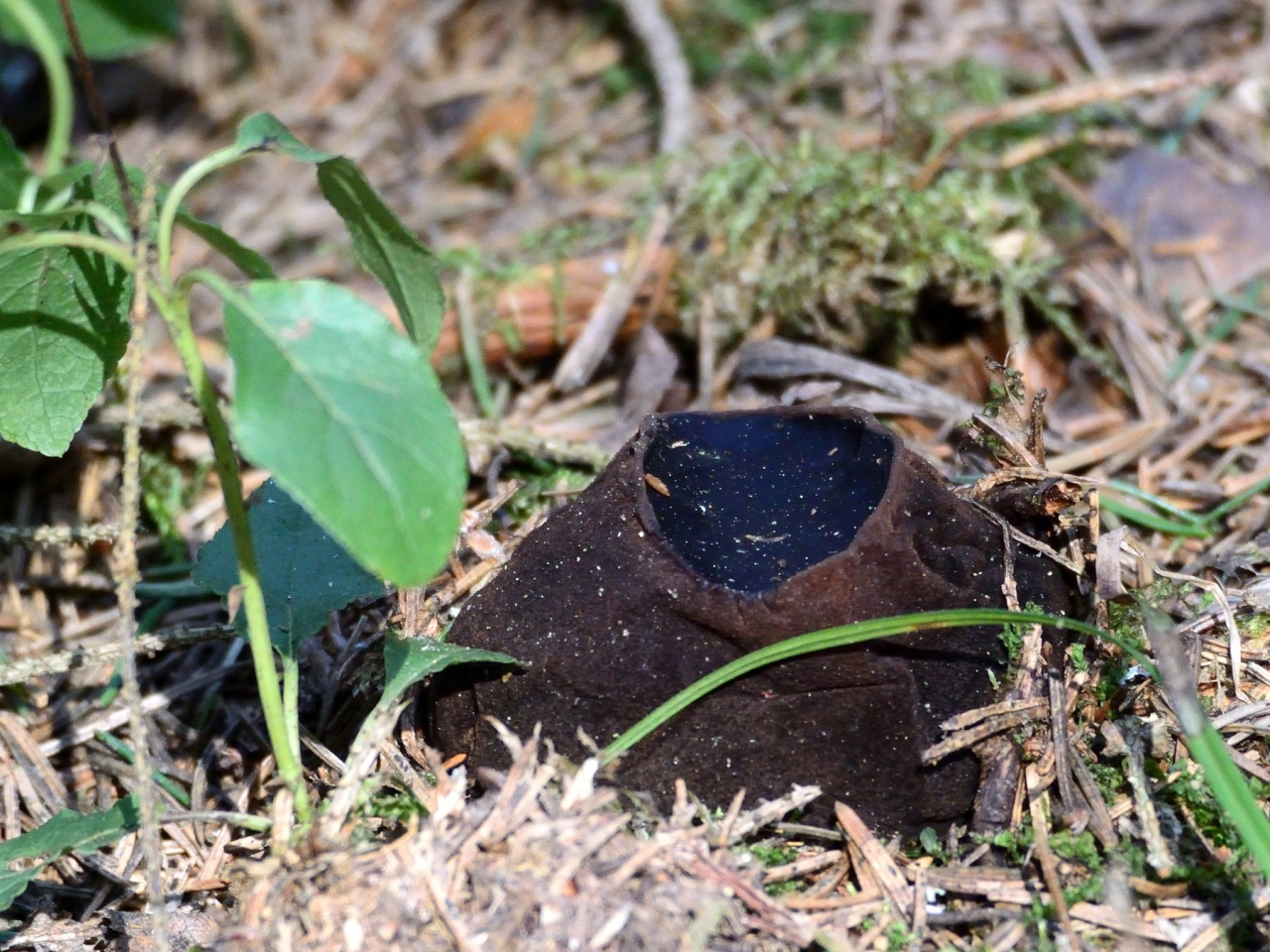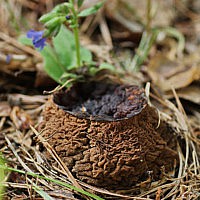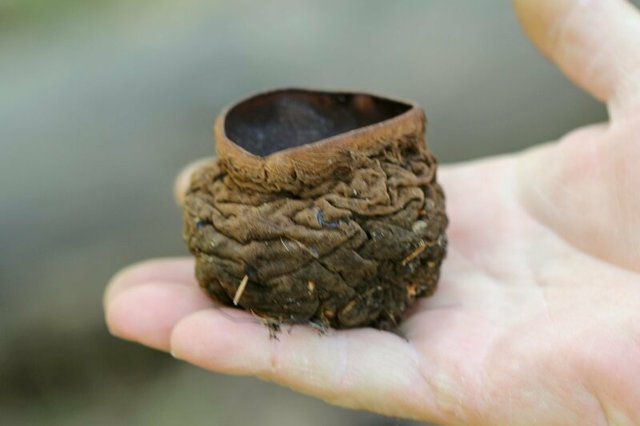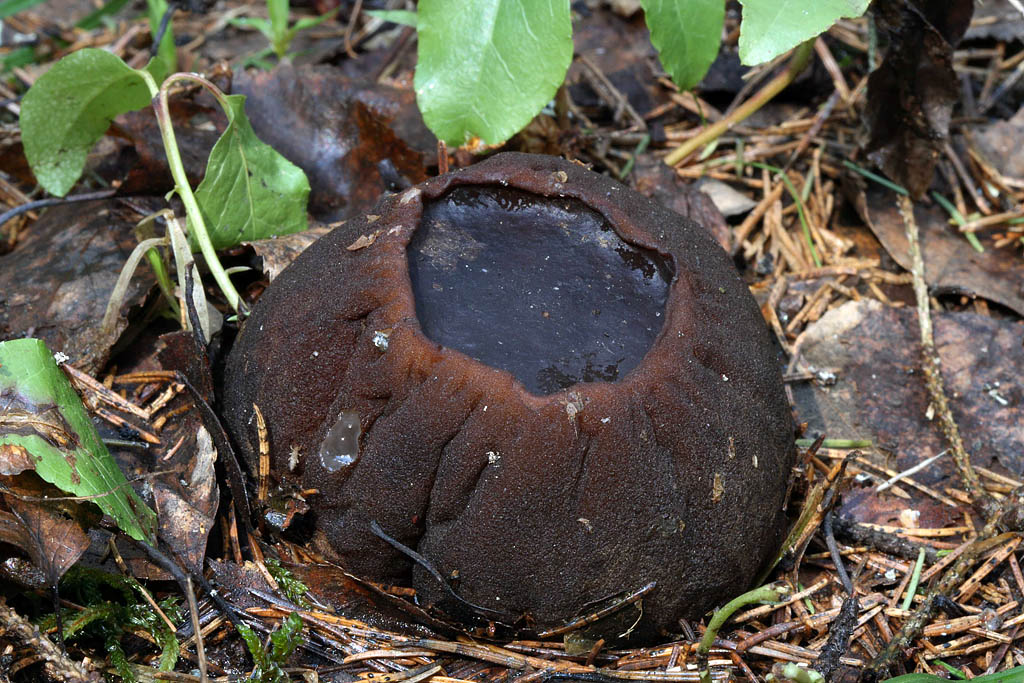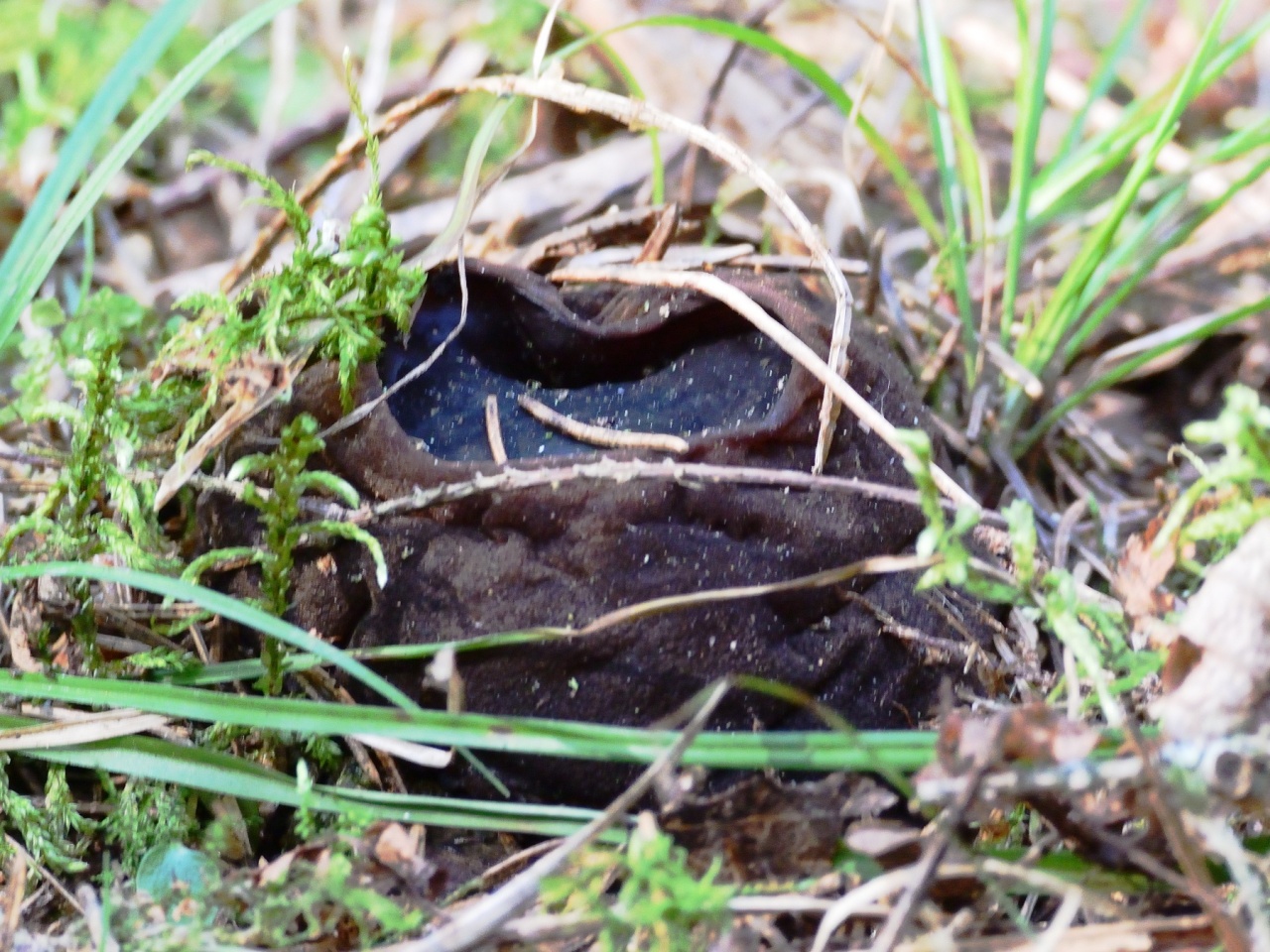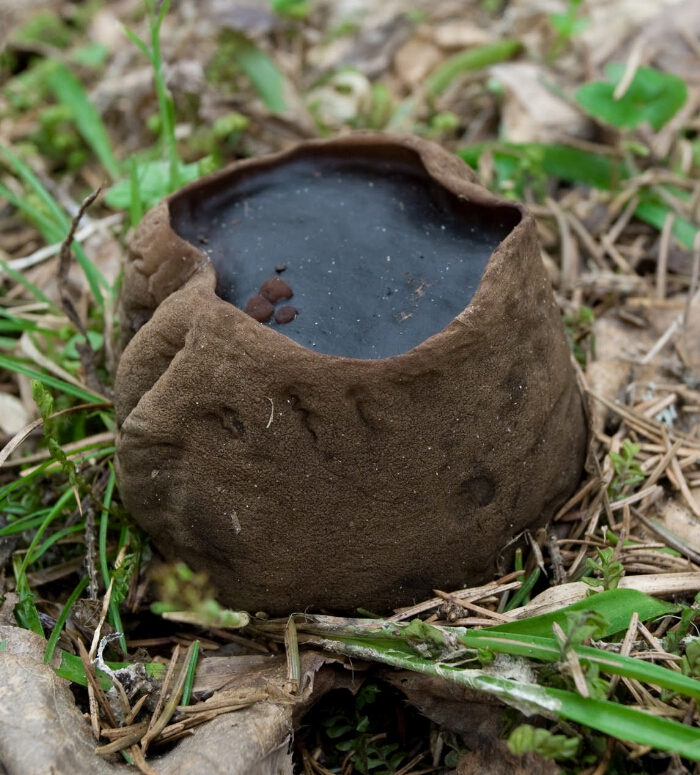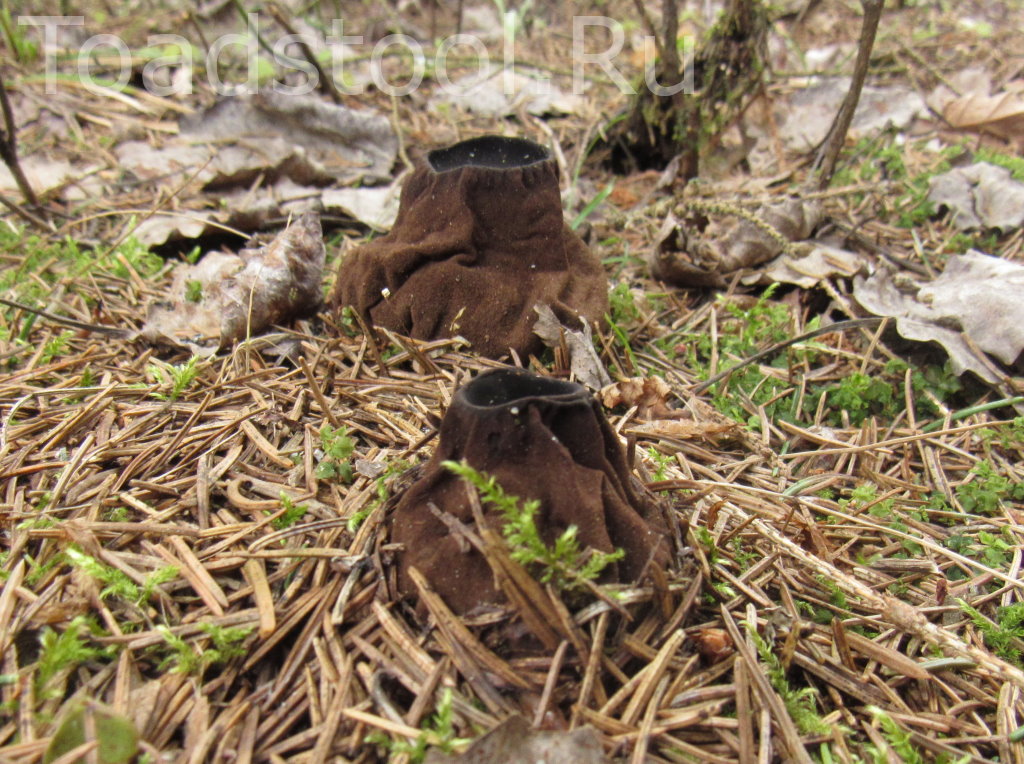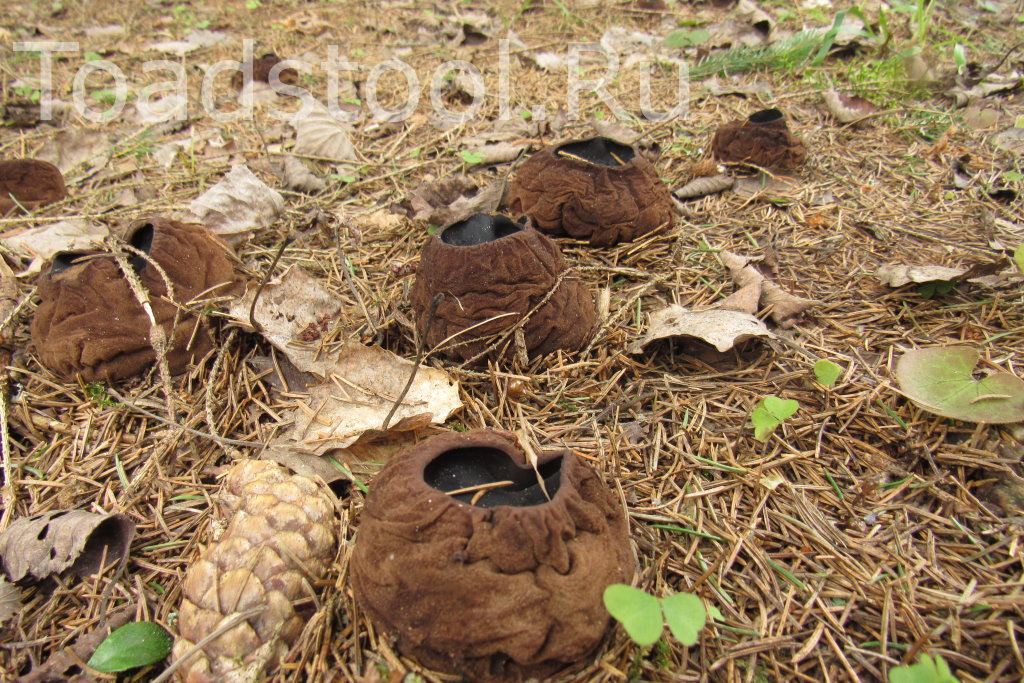Sarcosoma spherical
This fantastic mushroom changes its appearance several times throughout its life, and each time it is something special, alien. Globular sarcosoma is still a mystery to many, although scientists have been dealing with this fungus for more than a dozen years.
Spherical sarcosoma - Latin sarcosoma globosum
In another way, the fungus is called spherical Bulgaria.
Description of the mushroom
External characteristics
The height of the mushroom reaches 50-100 mm, the diameter is 30-80 mm. Bulgaria spherical goes through several stages of development: on the first it resembles a soft ball, on the second it becomes like an onion or a cone-shaped figure with a neck. The third stage involves "losing weight" of the fungus and "turning" the spore-bearing layer outward with the formation of another hole in the central part of the fruiting body, which is necessary for the release of fluid.
The surface of the mushroom, which does not have a leg, is like suede. In youth, it is smoothed, closer to old age - folded. It has a brown or brown color that darkens towards the base.
In the center of the fruit bodies, hymenium is formed in the form of jelly or skin of a coal gray, almost black shade. Under it lies mucus, or, as it is simply called, "earth oil", exuding a pleasant mushroom smell.
Elongated spores form in cylindrical bursae.
The life of the fungus lasts about two months, but often the mushrooms, swollen from the liquid, burst and die much earlier.
Growing places
Referring to saprophytes, Sarkosoma globular prefers mossy places and fallen needles in pine and spruce forests. It grows in Russian regions with a temperate climate and European countries, it is quite rare, since it bears fruit in eight to ten years. On Siberian soil, fruiting is more frequent.
The mushroom bears fruit in clusters, sometimes 2-3 pieces grow together. Harvested in early spring, until the end of May.
Edibility
Some sources claim that this sarcosome is not suitable for eating, in others it refers to conditionally edible mushrooms.
Despite the slightly appetizing appearance, some mushroom pickers are happy to prepare a "sarkosomnik" from it, fry and stew with potatoes. But most lovers of quiet hunting are just surprised by the appearance of the mushroom and pass by.
The healing properties of the globular sarcosoma
Someone uses unusual mushrooms for food, someone uses them to get rid of various ailments.
The fungus contains eighteen fatty acids, including stearic, palmitic and heptodecanoic, a special pigment (like chaga), as well as many amino acids in the form of glycine, lysine, cysteine, arginine, etc. Due to such a useful composition, this sarcosome has the following healing properties:
- Improving brain activity. To do this, "earth oil" is taken daily on an empty stomach.
- Increasing the tone of the body. Jelly-like mucus strengthens the immune system, rejuvenates the body, calms the nervous system and restores strength after fatigue.
- Treatment of stomach diseases. The fungus helps in the treatment of gastritis and other stomach ailments.
- Strengthening hair follicles. Mushroom liquid nourishes the hair follicles and accelerates hair regrowth. It is rubbed into the scalp.
- Skin rejuvenation. The walls of the fruiting body are crushed and used as a mask for skin rejuvenation.
- Joint treatment. Rubbing alcohol tincture of the walls of fruit bodies helps with polyarthritis, rheumatism and other joint diseases.
Some sources claim that Sarcosoma spherical in the form of intramuscular injections of its juice is used in the treatment of cancer.
Spherical sarcosoma - description, where it grows, the toxicity of the fungus
Noticing a spherical sarcosoma in the forest, an inexperienced mushroom picker, most likely, will not understand that under his feet a mushroom representative, however, is so rare that any mycologist will envy that he was lucky to see him.
Unique mushroom without stem
Spherical sarcosoma is admired even by scientists, it is so unusual, and although it is considered inedible, it brings invaluable benefits to people.
Refers to the ascomycete representatives of the sarcosomaceae family. It also has another name - spherical bulgaria.
The fruiting body of the fungus itself is rather large and, as the name confirms, is spherical, but sometimes it is in the form of a bulb or a cone. A young specimen may have a cylindrical shape. The height of the mushroom can reach from 3 to 9.5 cm, the diameter is from 3 to 8 cm.
The upper part is saucer-shaped, and at the top, in the very middle of the body, there is a hymenium, which has a black-brown or completely dark shade and is a jelly-like or so-called leathery film. The hymenium is slightly depressed inward to preserve the contents of the mushroom.
Outwardly, the globular sarcosoma is very similar to a pot-bellied small barrel with a neck, which is filled with a clear, light liquid. Looks like a fairytale hero of a magical forest. The color of the fruiting body is usually brown or dark brown, but in the lower part it is always darker in color.
The fruiting body has a soft texture, the skin is soft, smooth and velvety. The surface is uneven. May be moderately wrinkled or completely wrinkled in older specimens. At the base, large hyphae are visible - rhizomorphs, which stretch only a few centimeters.
Why the mushroom needed this watery consistency, scientists still argue. It was once thought that it was spore-bearing, but it turned out that the formation of spores occurs in asci (they have the shape of cylinders). They are located on a surface resembling a lid. It is assumed that when the fungus reaches a certain age, the liquid enters the bags. Because of this, they break apart, and the spores end up outside. There is also an opinion that the sarcosome needs this liquid as food and to increase its size, so that excess forces are not wasted to add mass.
The scattered spores then begin to germinate, but can quickly die if the conditions are not met.
Mushrooms usually live no more than 60 days. When they swell, they burst rather quickly, and this is the most compelling reason why it is rare to find a mushroom that has survived to old age.
During the period of his life, he undergoes amazing changes, his many secrets have not been fully solved, so he always attracts the attention of scientists
Distribution locations
The mushroom's favorite habitat is coniferous forests. There are always a lot of fallen needles and an abundance of moss - the most attractive conditions for spherical sarcosoma. Since, in fact, these are saprophytes, they are always in dense grass, and therefore it is difficult to find mushrooms. But, if one is found, it means that there may be another 8 - 10 pieces nearby. They grow singly, but they can grow together.
It is believed that if a bountiful harvest of mushrooms is needed, then it is possible to harvest it only once every 8 - 10 years. Collect it in late April and May. In the regions of Siberia, these mushrooms can be found immediately after the snow cover has melted. They grow on the territory of Europe, and also have, as you know, arctic-alpine distribution.
This mushroom is listed in the Red Book in various regions of Russia. Due to its uniqueness, globular sarcosoma does not look like any other species, so it is impossible to confuse it with another fungus.
Medicinal properties and uses
This mushroom is used by folk healers. They are especially attracted to the liquid. As it turned out, it is rich in valuable substances - amino acids, as well as fatty acids useful for the human body. Excellent medicinal products are obtained from earthen oil for the treatment of sciatica, relieving nervous tension.Many doctors are confident that the mushroom has a fast-acting rejuvenating effect, it helps accelerated hair growth, therefore it is actively used by cosmetologists. Ointments and tinctures are prepared from this mushroom, as well as effective decoctions and masks.
It is believed that globular sarcosoma can fight cancer cells and stimulate brain activity.
Interesting facts about the mushroom
- According to some scientists, globular sarcosoma is able to fight cancer cells.
- In some sources, sarcosoma is referred to as an inedible mushroom species. But in some regions of Russia it is fried or stewed with potatoes. The dish is called "sarkosomnik".
- It is believed that a rich cam crop can be harvested no more often. than once every 8-10 years. It is with this frequency that the mushroom throws out fruiting bodies.
- Earth oil has a unique composition that can treat a wide variety of diseases, even cancer.
Sarcosoma is a mushroom, not only rare in prevalence, but also extremely useful. Not knowing what it is and how to use it, you can walk by without risking putting it in the basket. Having an idea of its unique composition and properties, one would hardly want to miss the chance to improve one's health with the help of such a magnificent gift of nature.
Marsupial mushrooms - Ascomycetes
Family Sarcosomataceae - Sarcosomataceae
Sarcosoma spherical
Sarcosoma globosum (Schmidel) Rehm Category and status. 2 a - a species that is decreasing in numbers as a result of changes in conditions of existence and destruction of habitats. A brief description of. Fruit bodies develop in groups, at first almost spherical, later barrel-shaped, gelatinous, 3-12 cm in diameter, wrinkled outside, dark brown, with a black-brown, shiny, flat or slightly concave disc. The pulp is thick, almost colorless, gelatinous (1). Breaks in fruiting can last up to 10 years. April May.
Spreading. In Russia: Komi Republic (2), Tatarstan (3), Udmurt Republic (4), Khanty-Mansi Autonomous Okrug (5), Krasnoyarsk Territory (6), Astrakhan (7), Kaliningrad (8), Kirovsk (9), Leningradskaya (10), Moscow (11), Novosibirsk (12), Pskov (15), Sverdlovsk (16), Tambov (17) Regions, Perm Territory (13, 14). General distribution: outside of Russia found in Central and Northern Europe, in the Caucasus, in the east of North America (18-20). Features of ecology and phytocenology. Saprotroph. Found on soil in spruce and mixed with spruce, less often in pine forests.
The number. Not known.
The state of local populations. Not investigated.
Limiting factors. None known.
Security measures taken. It is included in the Red Data Books of the Komi Republic (2), the Udmurt Republic (4), Khanty-Mansi Autonomous Okrug (5), Astrakhan (7), Kirov (9), Tambov (17) Regions. , The Middle Urals (Sverdlovsk and Perm regions) (14, 16), nature of the Leningrad region. (ten). Protected in the Yugansk Reserve (21).
Necessary security measures. Conservation of habitats of the species.
Cultivation opportunities. Not studied.
Sources of information. 1. Garibova, Sidorova, 1997; 2. Red Data Book of the Komi Republic, 1998; 3. Vasilieva, 1977; 4. Red Data Book of the Udmurt Republic, 2001; 5. Red Data Book of the Khanty-Mansiysk Autonomous Okrug, 2003; 6. Vasina, 2006; 7. Red Data Book of the Astrakhan region, 2004; 8. Dedkov et al., 2007; 9. Red Data Book of the Kirov region, 2001; 10. Red Data Book of Nature of the Leningrad Region, 2000; 11. Gorlenko et al., 1989; 12. Perova, Gorbunova, 2001; 13. Suzev, 1914; 14. About the list ..., 2001; 15. Data of the originator; 16. Red Book of the Middle Urals, 1996; 17. Red Data Book of the Tambov Region, 2002; 18. Dahlberg, Croneborg, 2006; 19. Nanagulyan, 2005; 20. Seaver, 1961; 21. Zvyagina et al., 2007. Compiled by E.S. Popov.
AOF | 12/01/2014 23:03:31
Description of the fungus spherical sarcosoma
Among the variety of mushrooms, there are those that are used for medicinal purposes. One of them is a mushroom spherical sarcosoma.
Botanical characteristic
Globular sarcosoma is referred to as marsupials (ascomycetes), which have septate mycelium and specific sporulation organs in the form of bags, called asci. The mushroom leg is missing.
The fruiting body, called the apothecium, initially has the shape of a ball, and over time takes the form of a bulb. As a single specimen matures, wrinkled folds appear on the surface of the fruiting body, it becomes soft in structure, bag-like in shape, while maintaining the velvety of the outer layer.
The color is dark brown or dark brown. The diameter of the fruit body is 6-8 cm. The height is 5-10 cm. The surface is velvety.
According to the external description, it looks like a keg with a lid filled with liquid.
Sarcosoma is poisonous, conditionally edible. Refers to saprophytes, lives on the dead remains of living things.
Geography of distribution
Arctic-Alpine distribution. Rarely found in areas of Central Europe. Preferred growing places are coniferous forests. Can be found in layers of moss or fallen needles.
Mass appearance is rarely observed - once every 3-4 years. Life expectancy is no more than 2 months.
Grows in small groups of 8-10 pieces. The largest number of congestions is in the Siberian taiga. The species is rare and is included under the protection of the Moscow, Kirov, Tyumen, Arkhangelsk regions and is on the list of the Red Book of Tatarstan.
Practical use
The conditionally edible mushroom is used to make potato stews called sarcos.
The main thing is related to its medicinal properties. The interior contains earth oil, a gelatinous jelly-like mass that includes fatty acids (palmitic, stearic, heptodecanoic) and a number of amino acids (including cysteine, lysine, glycine, valine, etc.). Thanks to this, it is mono to highlight the following healing properties:
- possesses biostimulating qualities that provide a rejuvenating effect on the body, increases the efficiency of the immune system, gives vitality;
- external use of mushroom tinctures allows you to relieve pain symptoms in rheumatism, polyarthritis and other joint diseases;
- sarcos tinctures drunk on an empty stomach
- crushed mushroom walls are used as rejuvenating masks for the face and body, strengthens hair follicles, acting as an effective remedy against hair loss;
Recently, traditional medicine has been widely investigating the positive effects on the body of intramuscular injections with mushroom extract in the fight against cancer.
TREMELLA MESENTERICA
System:
NormalfalsefalsefalseRUJAX-NONE
Kingdom: Mushrooms (Fungi)
Department: Basidiomycota
Class: Tremellomycetes
Order: Tremellales
Family: Tremellaceae
Genus: Tremella
Species: Tremella mesenterica (Batsch) Šutara (1992)
Fruit body: pale yellow, yellow, sometimes to orange, partly transparent, 1-10 cm, at a young age cerebral, later folded, gelatinous, dense gelatinous, often with a sticky surface. In dry weather, the fruit bodies dry out, taking the form of crusts adhering to the substrate. When the humidity changes, the crusts swell and the mushroom regains its normal shape. With excessive moisture, it fades to white, translucent. Old fruit bodies dry out, darken, become flattened and coarser. Habitat: like the fucus-shaped shiver, this fungus parasitizes on the mycelium of the host fungus (tinder fungus of the genus Peniophora) located in rotting wood. Following the host fungus, it settles on the trunks, branches and stumps of deciduous, much less often conifers. Sometimes there is a simultaneous fruiting of the tremor and the peniophora affected by it.
Fruiting period: from August to May (freezes in winter and continues to develop in a thaw). Distribution in the Russian Federation: throughout the forest zone, often abundantly in places.
Similar species: Fruit bodies, discolored to white in rainy weather, can be confused with trembling fucus. But only in the Primorsky Territory.
Edible: the mushroom is edible, used fresh for salads (with the addition of sweet and sour dressing). From fresh or dried fruit bodies, nutritious broths are cooked.
In China, it is considered a delicacy; among other recipes, it is used to prepare immunomodulatory cold vegetarian soups (with the addition of lotus seeds, lily bulbs, Chinese dates, etc.).
Medicinal properties: the biologically active polysaccharide glucuronoxylomannan was isolated from the orange shiver. Laboratory tests have shown that it has immunostimulating, radioprotective, antidiabetic, anti-inflammatory and anti-allergenic activity, and also participates in the protection of the liver (hepatitis B).
Ethanol extract of fresh fruit bodies causes complete death of A549 cancer cells (lung cancer), increases the production of interferon and interleukin-2, kills cervical cancer cells and enhances the effect of chemotherapy.
In China, on the basis of glucuronoxylomannan, several medications are patented (antineoplastic, anti-inflammatory, blood pressure regulating).
Fruit bodies of tremors contain essential amino acids and B vitamins, which makes these mushrooms valuable not only in medicinal, but also nutritionally.
For medicinal products, the mushroom is cultivated by the deep method (China).
In Chinese folk medicine, the orange tremor was used as a general tonic, for the treatment of pulmonary diseases, bronchitis, as well as for paralysis, eye inflammation, and as a sedative. Known use in England (rubbing with a fresh fruiting body) for the healing of skin ulcers.
Cookie Policy Mikhail Vishnevsky, 2012-2019 Log out | EditLAT Tremella mesenterica Edible Synonyms: Filmy Tremella, Dragla, Helvella mesenterica, Hormomyces aurantiacus, Tremella brasiliensis, Tremella lutescens, Tremella lutescens var. brasiliensis
Specifications:
| Group: | Indefinite |
|---|---|
| Plates: | Absent |
| Colour: | White to orange |
| Info: | Jelly-like fruiting body |
Systematics:
| Department: | Basidiomycota (Basidiomycetes) |
|---|---|
| Subdivision: | Agaricomycotina (Agaricomycetes) |
| Class: | Tremellomycetes (Tremellomycetes) |
| Subclass: | Tremellomycetidae (Tremellomycetids) |
| Order: | Tremellales |
| Family: | Tremellaceae (trembling) |
| Genus: | Tremella |
| View: | Tremella mesenterica (Orange trembling) |
The mushroom is edible, but practically not used in Russia. This is due to the difficulty of transporting this mushroom from the place of collection (it dissolves quickly).
Globular sarcosoma: what does the rarest mushroom look like?
Spherical sarcosoma is a representative of the genus Sarkosoma, of the family - Sarcosomaceae. This mushroom is also called spherical bulgaria. It is an inedible mushroom.
The Latin name for the fungus is Sarcosoma globosum.
Description of the globular sarcosoma.
The fruiting body of the sarcosoma is globular, large, 3-9.5 centimeters high, and in girth it can be 3-6 centimeters. The weight of the mushroom ranges from 20 to 220 grams, together with the liquid.
The shape of young mushrooms is cylindrical or spherical, while the upper part is saucer-shaped. At the top is the hymenium. That is, outwardly, the mushroom resembles a barrel with a lid filled with a light transparent liquid.
The surface of the fruit body is uneven, wrinkled or slightly wrinkled. The color of the fruiting body is brown or dark brown, and the hymenium is black-brown. At the base of the fungus there are large hyphae called rhizomorphs. They stretch for several centimeters. Spores are colorless.
In a wet state, the spherical sarcosoma is filled with a colorless watery-gelatinous mass, which resembles gelatin in consistency. When dry, the mushroom becomes flat. The hyphae of the pulp are immersed in the gelatinous pulp.
Places of growth of spherical sarcosoma.
This is a saprotroph-ascomycete mushroom. Globular sarcosomes grow on the soil, they hide in the spruce and moss litter. You can find these mushrooms in spruce-fir, cedar-fir and dark coniferous forests. Most often they grow together in groups of 8-10 pieces.
Most of the fungus is almost completely hidden in the moss, and only the upper part is visible outside. Globular sarcosomes grow in the Perm and Pskov regions of Western Siberia. They are also common in Europe and North America. They bear fruit from April to May.
In Europe, the number of these mushrooms is declining. Globular sarcosomas were found in the south of the Leningrad region. They were also found on the Karelian Isthmus.
The number of spherical sarcos.
Globular sarcosoma is a rare mushroom listed in the Red Book of Russia. In some years, they can be quite abundant in Western Siberia, but most often they are very rare. Globular sarcosomas appear en masse once in 8-10 years.
The development of new territories and deforestation have become the reason that these mushrooms are almost impossible to find in nature. Any new places are recorded and marked on the map.
Reproduction of globular sarcos.
The fluid of the fungus contains sugars, with their help, pressure is created inside the apothecia, which contributes to the ejection of ripe spores. Spores are ejected every 3 minutes at high pressure. As the liquid is thrown away, its amount decreases, and the mushroom becomes shriveled, like a black plate.
Globular sarcosomes bear fruit in the spring, sometimes even from under the snow. Scattered spores germinate, but die immediately, since they need special conditions for growth. These mushrooms can only grow on a moss bed, and they must be located far from civilization.
If the spore penetrates deep into the moss, then it develops under favorable conditions, and a new fungus grows after a few years. Spores can be stored for years or even decades, which is why periodic growth is noted. Finding these rare mushrooms is also difficult because they perfectly camouflage themselves among the moss.
The healing properties of globular sarcos.
These mushrooms are used in folk medicine as a remedy for rheumatism. The lower back is rubbed with the internal mass of the mushroom. The spherical sarcosoma fluid contains sugars, for which it is highly valued and used as a medicine. This liquid contains 18 fatty acids. This liquid helps to boost immunity. If you rub it into the scalp, it accelerates hair growth.
Nourishing masks for the skin are made from the walls of the mushroom. Alcohol tinctures are made from them. The preparation "Earthen Oil" is prepared from the globular sarcosoma. This is not just a cosmetic product, but also a cure for many diseases.
Scientists have not fully discovered all the medicinal possibilities of globular sarcosoma. The liquid and the walls of this mushroom contain very rare proteins that cannot be synthesized artificially.
Places of growth of spherical sarcosoma.
This is a saprotroph-ascomycete mushroom. Globular sarcosomes grow on the soil, they hide in the spruce and moss litter. You can find these mushrooms in spruce-fir, cedar-fir and dark coniferous forests. Most often they grow together in groups of 8-10 pieces.

Most of the fungus is almost completely hidden in the moss, and only the upper part is visible outside. Globular sarcosomes grow in the Perm and Pskov regions of Western Siberia. They are also common in Europe and North America. They bear fruit from April to May.
In Europe, the number of these mushrooms is declining. Globular sarcosomas were found in the south of the Leningrad region. They were also found on the Karelian Isthmus.

It is an inedible species that is not used for food.

The number of spherical sarcos.
Globular sarcosoma is a rare mushroom listed in the Red Book of Russia. In some years, they can be quite abundant in Western Siberia, but most often they are very rare. Globular sarcosomas appear en masse once in 8-10 years.
The development of new territories and deforestation have become the reason that these mushrooms are almost impossible to find in nature. Any new places are recorded and marked on the map.
Reproduction of spherical sarcos.
The mushroom liquid contains sugars, with their help, pressure is created inside the apothecia, which contributes to the ejection of ripe spores. Spores are ejected every 3 minutes at high pressure. As the liquid is thrown out, its amount decreases, and the mushroom becomes shriveled, like a black plate.

Globular sarcosomes bear fruit in the spring, sometimes even from under the snow. Scattered spores germinate, but die immediately, since they need special conditions for growth. These mushrooms can only grow on a moss bed, and they must be located at a distance from civilization.
If the spore penetrates deep into the moss, then it develops under favorable conditions, and a new fungus grows after a few years.Spores can be stored for years or even decades, which is why periodic growth is noted. Finding these rare mushrooms is also difficult because they perfectly camouflage themselves among the moss.

Healing mushroom Sarcosoma globosum (Sarcosoma globosum)
During the Yaransk "epic" in May last year, I happened to meet an unusual, rare (included in the Red Book of the Kirov region), but at the same time considered very healing (almost a panacea for all diseases) mushroom - Sarcosoma globosum (Sarcosoma globosum ), popularly called "earthen oil".
The fruiting bodies of sarcosoma appear very early in the spring, even before morels and lines appear. Sometimes there is still snow around, and these small "barrels" grow on patches of thawed earth.
The fruit body of young mushrooms is buried in moss, 5-10 cm high and 3-7 cm in diameter, barrel-shaped, dark brown or dark brown in color. As it grows, folds form on the body of the fungus, it becomes softer and sack-like, velvety on the outside. Occurs in small groups of 8-10 pieces.
Globular sarcosoma is a very rare mushroom; it is listed in the Red Book of both the Kirov region and other regions. It is believed (although perhaps this is just a delusion) that the mass appearance of sarcosoma fruiting bodies is very rare. According to various sources, this can happen once every 3 years, and even once every 8-10 years. In other years, almost never occurs.
The mushroom looks like a barrel with a lid, filled inside with a transparent light liquid, which is popularly called "earth oil", as is often the mushroom itself. It is believed to have medicinal properties. This gelatinous jelly-like mass contains 18 fatty acids and a number of amino acids - glycine, cysteine, valine, histidine, lysine. It is considered a good biostimulator, it is able to have a rejuvenating effect on the body, relieves nervous tension, it is used as a remedy against rheumatism. Some endow it with absolutely fantastic properties - up to the treatment of oncology with the help of intramuscular injections.
I tried this liquid - nothing special. A liquid and slightly slimy substance with a faint mushroom odor and no pronounced taste. No immediate consequences from such a small dose happened to me.
In the vastness of the Siberian taiga, in some places, this mushroom is very common, and contrary to the instructions of most reference books, it is quite edible. Young mushrooms are stewed there together with potatoes in their own juice, getting a specific, but very tasty dish - sarcos. Igor Krom writes about this in detail in his report.
Here I have presented not very successful photos - I was too lazy to uncover the tripod, and there is little light in the forest. I advise you to look at more successful pictures in the blog of Sergey Talanov.
Conclusion
The mushroom spherical sarcosoma is a representative of the ascomycetes. The species is inedible, cannot be used for food purposes, however, some residents of the northern regions cook homemade dishes with it. It has medicinal properties, therefore it is applicable in folk medicine in the treatment of a number of diseases. This is a rare species. The conservation status is close to a vulnerable position, it is included in the Red Data Books of a number of Russian regions and the Red Data Book of the Russian Federation.

